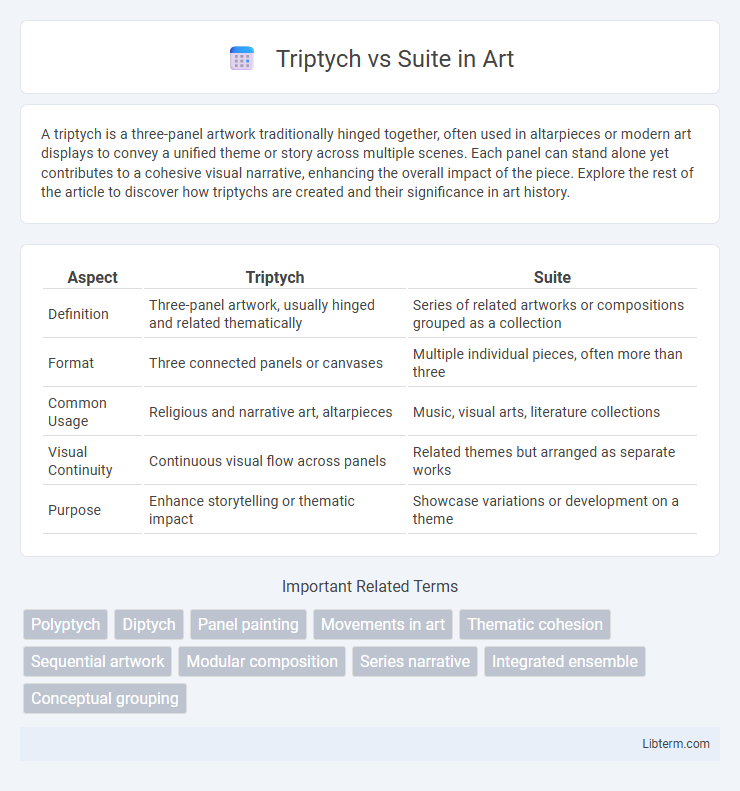A triptych is a three-panel artwork traditionally hinged together, often used in altarpieces or modern art displays to convey a unified theme or story across multiple scenes. Each panel can stand alone yet contributes to a cohesive visual narrative, enhancing the overall impact of the piece. Explore the rest of the article to discover how triptychs are created and their significance in art history.
Table of Comparison
| Aspect | Triptych | Suite |
|---|---|---|
| Definition | Three-panel artwork, usually hinged and related thematically | Series of related artworks or compositions grouped as a collection |
| Format | Three connected panels or canvases | Multiple individual pieces, often more than three |
| Common Usage | Religious and narrative art, altarpieces | Music, visual arts, literature collections |
| Visual Continuity | Continuous visual flow across panels | Related themes but arranged as separate works |
| Purpose | Enhance storytelling or thematic impact | Showcase variations or development on a theme |
Introduction to Triptychs and Suites
Triptychs and suites are both important formats in visual and musical arts, respectively; a triptych traditionally consists of three connected panels displaying a unified narrative or theme, often used in religious or historical art. Suites in music comprise a set of instrumental compositions which are stylistically related, frequently arranged to be performed in sequence, originating from Baroque dance forms. Understanding the structure and purpose of triptychs and suites provides insight into how artists and composers organize and present thematic content across multiple works.
Defining the Triptych in Art and Music
A triptych in art is a three-paneled work often hinged together, allowing the panels to be displayed open or closed, with each panel contributing to a thematic or narrative whole. In music, a triptych typically refers to a composition divided into three distinct yet interconnected movements or sections that explore related motifs or concepts. This three-part structure contrasts with a suite, which comprises multiple separate pieces or movements, often more numerous and less thematically unified than a triptych.
Understanding Suites: Structure and Purpose
A suite is a cohesive collection of musical or artistic pieces linked by a common theme or style, designed to be performed or viewed in sequence. Unlike a triptych, which consists of three distinct panels or sections, a suite can comprise multiple movements or parts, each contributing to an overarching narrative or emotional progression. The structure of a suite emphasizes unity through variation, allowing for diverse expressions within a single conceptual framework.
Historical Origins of Triptychs and Suites
Triptychs originated in early Christian and medieval art, primarily as three-paneled altarpieces designed to depict religious narratives with a central panel flanked by two hinged wings. Suites emerged during the Baroque period in music, referring to a set of instrumental or dance movements unified by key or theme, reflecting the evolution of courtly entertainment. Both forms illustrate historical transitions in art and music, with triptychs rooted in visual storytelling and suites developing from the structure of dance compositions.
Key Differences Between Triptych and Suite
A triptych consists of three related artworks or panels that are intended to be viewed together as a single piece, often linked by a common theme or narrative. A suite, on the other hand, refers to a set of coordinated works, such as musical compositions or artworks, designed to be performed or displayed sequentially but can also stand independently. Key differences include the triptych's fixed three-panel format and visual unity versus the suite's flexibility in the number and independence of its components, focusing more on thematic or stylistic cohesion than strict presentation structure.
Notable Examples of Triptychs in Various Mediums
Notable examples of triptychs span various mediums, with Hieronymus Bosch's "The Garden of Earthly Delights" standing as a seminal triptych masterpiece in painting, while Robert Rauschenberg's "Canyon" represents an influential sculptural triptych. In photography, Duane Michals' narrative sequences often utilize the triptych format to convey complex stories across three panels. These works highlight the triptych's versatility in visual storytelling across different artistic disciplines.
Famous Suite Compositions and Artworks
Famous suite compositions such as Tchaikovsky's "The Nutcracker Suite" and Bach's "Orchestral Suites" showcase a series of musical movements linked by thematic elements, offering a dynamic auditory experience. In the visual arts, triptychs like Hieronymus Bosch's "Garden of Earthly Delights" and Francisco Goya's "Black Paintings" present three interconnected panels that explore complex narratives or contrasts across a single work. Both formats emphasize unity and variation, with suites unfolding over time in music and triptychs providing a spatial storytelling structure in art.
Artistic Intent: Narrative vs Thematic Unity
A triptych emphasizes artistic intent through a narrative structure, where each panel sequentially contributes to a cohesive story or message. In contrast, a suite prioritizes thematic unity, presenting a collection of works connected by a consistent theme or concept rather than a linear progression. This distinction highlights how triptychs engage viewers with evolving narratives, while suites offer varied interpretations centered around shared motifs.
Contemporary Uses of Triptychs and Suites
Contemporary uses of triptychs often involve multi-panel artworks that explore thematic or narrative continuity, blending visual storytelling with modern media such as digital prints and mixed media installations. Suites, in contrast, are sequences of related works or compositions, frequently employed in music and visual arts to convey variations on a central theme, emphasizing cohesion through style and mood. Both triptychs and suites serve as dynamic formats for artists to experiment with progression and segmentation, enhancing the viewer's engagement with evolving concepts across multiple pieces.
Choosing Between Triptych and Suite for Creative Projects
Choosing between a triptych and a suite for creative projects depends on the desired narrative structure and visual impact; triptychs provide a cohesive storytelling format through three interconnected panels, ideal for focused thematic exploration. Suites offer a broader artistic range, presenting multiple pieces united by an overarching concept, which benefits projects requiring varied expressions within a single collection. Prioritizing the project's scope and thematic complexity guides the optimal selection between these two formats.
Triptych Infographic

 libterm.com
libterm.com